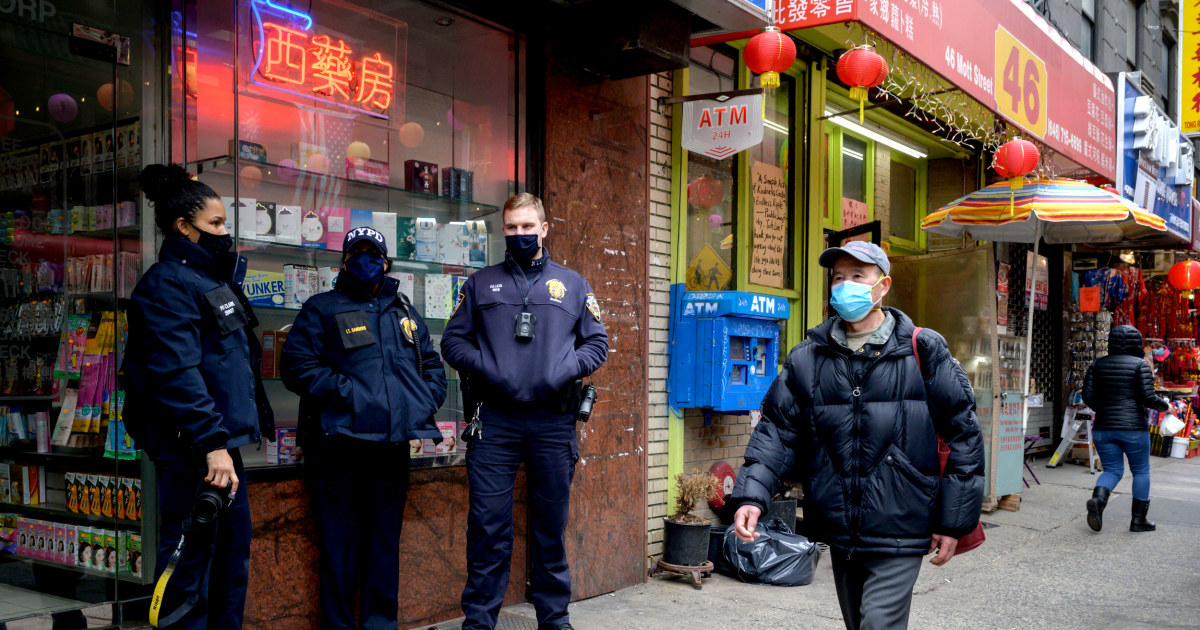
Dozens of Asian American and LGBTQ groups have raised concerns around the Covid-19 Hate Crimes Act, which passed in the Senate last month with nearly unanimous support.
More than 85 organizations, which range from the civic engagement nonprofit 18 Million Rising to the National Queer Asian Pacific Islander Alliance, a federation of Asian American LGBTQ organizations, released a statement this week in opposition to the legislation. The bill, which would in part direct the Department of Justice to expedite the review of hate crimes related to Covid-19 and bolster law enforcement to better collect data on such crimes, is expected to be taken up by the House this month and has already received support from President Joe Biden.
But the groups argue that the legislation fails to provide resources to address the causes of anti-Asian bias and, in turn, ignores police violence against Black and brown communities.
“What we’re trying to do is we’re calling for a redistribution of wealth and resources into things like health care, and housing, social services, because we know that’s at the root of the violence that we see in our communities, is due to inequality,” Jason Wu, co-chair of the GAPIMNY-Empowering Queer & Trans Asian Pacific Islanders, which helped spearhead the statement, told NBC Asian America. “The things that will keep us safe require us to think more long term and systemically about what the root causes of violence are.”
In the statement, the groups argued that “relying on law enforcement and crime statistics does not prevent violence,” citing the continued violence against trans people despite hate crime measures that should protect them. According to the Human Rights Campaign, at least 44 transgender or gender-nonconforming people were fatally shot or killed by other violent means in 2020 alone. The majority of the victims were Black and Latinx transgender women.
The organizations also point out that a great deal of violence comes at the hands of law enforcement. A study published in the Proceedings of the National Academy of Sciences cited police violence as the leading cause of death for young men in the U.S. Roughly 1 in every 1,000 Black men can expect to be killed by police, the researchers found.
“Hate crime classifications and statistics do not change the structural conditions that lead to violence against marginalized communities,” the statement reads.
In the context of the ongoing attacks on Asian Americans related to the pandemic, Wu said that law enforcement has not been helpful, or preventative.
“What the police do is that they show up afterwards, and they issue press releases. And they really take these horrific moments of pain and trauma, and they use it to demand more money for their budgets,” Wu said. “When we know that more policing and prisons is not keeping us safer, why is it that we continue to ask for the same approaches to violence and crime?”
Citing the case of Yao Pan Ma, a 61-year-old Chinese American man who was attacked while collecting cans to support his family — and remains in a coma — along with other victims of anti-Asian violence, Wu explained that many people and their families have had to crowdfund to cover their own health care and other costs, some of the most dire needs. Law enforcement does not aid in many of these critical essentials.
“Hate crimes, prosecution and incarceration of the attacker does nothing to address those needs,” Wu said. “It also doesn’t address the reality that, at least in New York City, many of the attacks involve people who do have mental health issues, who are poor, potentially homeless … we have to address inequality in our society.”
Rather than enacting hate crimes legislation, the organizations advocate for a shift in resources from law enforcement to community-based solutions including interventions and noncarceral alternatives. They demanded the removal of police from communities and instead called for investing in mental health care infrastructures, neighborhood trauma centers and community food banks among other programs.
In addition to such programs, the groups advocated for a reframing of bias violence, recognizing the topic as a public health issue and “so that public policy interventions can be based on noncriminal legal research and prevention efforts.”
“This means no partnerships, contracts, and arrangements between law enforcement and other entities, including data-sharing agreements,” the statement read.
It also reinforced the groups’ commitment to reject any solutions that address anti-Asian bias with those that are also “inherently anti-Black, anti-immigrant, and harmful for the most marginalized in our communities.”
Pawan Dhingra, a professor of American studies at Amherst College, also questioned how well such measures can even punish those with racial animus, given the difficulty of proving motive.
“How effective such legislation is in punishing race-based attacks is unclear,” he said. “Rarely do attackers utter racist remarks or leave clear signs of racial animus. Without such a smoking gun, it appears as if racism was not relevant, but that is too simplistic of an approach.”
Dhingra warned against law enforcement solutions, noting that the United States has historically used armed police to protect white, property-holding men. Experts note that the earliest forms of law enforcement include the policing of Native Americans by early New England settlers to colonial slave patrols that helped wealthy landowners maintain economic order.
Asian Americans, meanwhile, have a unique relationship with law enforcement, experts said. Due to the model minority myth and the stereotype that the group is law-abiding and “decidedly ‘not Black,’” some groups of Asian Americans have the privilege of relying on law enforcement, historian Ellen Wu said. Japanese and Chinese Americans, in particular, were first rebranded as “good citizens” beginning in the 1940s and the 1950s, she said.
“This meant that Japanese and Chinese enjoyed a perverse benefit — not being assumed to be criminals meant a relative freedom from surveillance, policing, and state-sanctioned violence as compared to Black people.”
Wu added that this allowed lawmakers to delegitimize the Black community’s grievances and justify the growing mass incarceration system.
But Asian Americans shouldn’t feel too comfortable, Dhingra said, pointing to the aftermath of the terror attacks of Sept. 11, 2001, when law enforcement was given broader powers to conduct surveillance on South Asian American and Muslim American communities.
“Every person should have a stake in how the government polices its people,” he said.
Many aren’t on board with the entire statement, however. Van Tran, a sociologist and associate professor at the City University of New York’s Graduate Center, said that while he agrees with the “spirit” of the statement and noted that a restorative justice model should be worked into criminal justice, he’s not in favor of a total eradication of law enforcement. He also disagreed with the statement’s opposition to the act in part due to its stance on data collection. He said that without statistics, the pain that the Asian American community is confronting is essentially erased by policymakers.
“If you don’t have data to show that phenomenon, then the phenomenon simply does not exist, because we live in a very quantified policy environment,” Tran said. “Lots of policymakers often say, ‘Where’s the data? Show me.’ Seeing is believing.”
In a pandemic when many elderly are uncomfortable or scared of leaving their homes, the bill also allows for people to report attacks online, something that will also encourage more accurate data collection, which shouldn’t be underestimated, Tran said.
Wu, of the GAPIMNY-Empowering Queer & Trans Asian Pacific Islanders, pointed out that there are ways to separate data collection from law enforcement, including the online reporting forum Stop AAPI Hate.
“More data is great. And at the same time, it does not need to be tied to policing or carceral approaches to this violence,” Wu said. “If the visibility is to basically support policing … It’s actually extracting resources from our communities that could go to addressing the fact that there are enormous income inequalities within the Asian American community.”
Source: | This article originally belongs to Nbcnews.com










